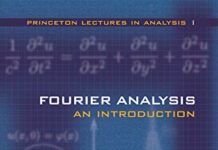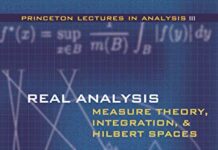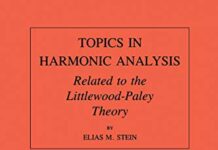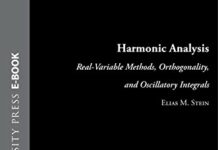
Ebook Info
- Published: 2011
- Number of pages:
- Format: PDF
- File Size: 11.53 MB
- Authors: Elias M. Stein
Description
This is the fourth and final volume in the Princeton Lectures in Analysis, a series of textbooks that aim to present, in an integrated manner, the core areas of analysis. Beginning with the basic facts of functional analysis, this volume looks at Banach spaces, Lp spaces, and distribution theory, and highlights their roles in harmonic analysis. The authors then use the Baire category theorem to illustrate several points, including the existence of Besicovitch sets. The second half of the book introduces readers to other central topics in analysis, such as probability theory and Brownian motion, which culminates in the solution of Dirichlet’s problem. The concluding chapters explore several complex variables and oscillatory integrals in Fourier analysis, and illustrate applications to such diverse areas as nonlinear dispersion equations and the problem of counting lattice points. Throughout the book, the authors focus on key results in each area and stress the organic unity of the subject. A comprehensive and authoritative text that treats some of the main topics of modern analysis A look at basic functional analysis and its applications in harmonic analysis, probability theory, and several complex variables Key results in each area discussed in relation to other areas of mathematics Highlights the organic unity of large areas of analysis traditionally split into subfields Interesting exercises and problems illustrate ideas Clear proofs provided
User’s Reviews
Opiniones editoriales Review “Functional Analysis by Elias Stein and Rami Shakarchi is a fast-paced book on functional analysis and related topics. By page 60, you’ve had a decent course in functional analysis and you’ve got 360 pages left.”—John D. Cook, Endeavour”Characteristically, Stein and Shakarchi reward readers for hard work by making the material pay off.” ― Choice”This excellent book ends with a proof of the continuity of the averaging operator and applications to the determination of remainder terms in asymptotic formulas for the counting function of lattice points. Reading this book is an enjoyable experience. The reviewer highly recommends it for students and professors interested in a clear exposition of these topics.”—Stevan Pilipovic, MathSciNet”This book is accessible for graduate students. Moreover, it plays the role of an instructional book in various branches of mathematical analysis, geometry, probability, and partial differential equations. In most mathematical centers one cannot expect that such lectures will be offered as a semester-long course to students, but both students and teachers have here an excellent guide for learning and teaching the topics presented in this volume. . . . Reading this book is an enjoyable experience. The reviewer highly recommends it for students and professors interested in a clear exposition of these topics.”—Stevan Pilipovit, Mathematical Reviews Review “This book introduces basic functional analysis, probability theory, and most importantly, aspects of modern analysis that have developed over the last half century. It is the first student-oriented textbook where all of these topics are brought together with lots of interesting exercises and problems. This is a valuable addition to the literature.”―Gerald B. Folland, University of Washington From the Inside Flap “This book introduces basic functional analysis, probability theory, and most importantly, aspects of modern analysis that have developed over the last half century. It is the first student-oriented textbook where all of these topics are brought together with lots of interesting exercises and problems. This is a valuable addition to the literature.”–Gerald B. Folland, University of Washington From the Back Cover “This book introduces basic functional analysis, probability theory, and most importantly, aspects of modern analysis that have developed over the last half century. It is the first student-oriented textbook where all of these topics are brought together with lots of interesting exercises and problems. This is a valuable addition to the literature.”–Gerald B. Folland, University of Washington About the Author Elias M. Stein is the Albert Baldwin Dod Professor of Mathematics at Princeton University. Rami Shakarchi received his PhD in mathematics from Princeton University. They are the coauthors of Complex Analysis, Fourier Analysis, and Real Analysis (all Princeton). Leer más
Reviews from Amazon users which were colected at the time this book was published on the website:
⭐Functional analysis is the fourth and final book in Elias Stein’s and Rami Shakarchi’sPrinceton lectures in analysis. Elias Stein is a world authority on harmonic analysis and it is not surprising therefore that the first book in the series was on Fourier analysis. The second and third books covered complex and real analysis. He is also a winner of the prestigious Wolf Prize which is granted, at least in part, for excellence in communication of mathematical ideas: “For his contributions to classical and Euclidean Fourier analysis and for his exceptional impact on a new generation of analysts through his eloquent teaching and writing.”These books were based on lectures given at Princeton and therefore reflect the standard of mathematics teaching at Princeton, but more importantly they reflect what Stein wanted to do by bringing together a life time of knowledge and insights concerning Fourier theory. My understanding (which comes from someone within the functional analysis “mafia”) is that Professor Stein really wanted to set a benchmark for doing Fourier series and functional analysis properly and that has informed the way he has approached these four books. The synthesis of ideas is excellent and even though I learned Fourier theory from a very able man, I was always hankering for the bigger deal – the broader connections. At the top level of mathematics the “helicopter” view is actually the hardest thing to do – just think of Littlewood’s three principles: (a) every measurable set is nearly a finite sum of intervals; (b) every absolutely integrable function is nearly continuous; and (c) every pointwise convergent sequence of functions is nearly uniformly convergent. These three simple principles are but the tip of a massive analytical iceberg.It is clear that there is a real passion for Fourier series and its tantalising applications which are extraordinarily diverse. When Fourier initially developed the seemingly outrageous theory in the early part of the 19th century, little did he know the astonishing applications that his theory would have. The sheer generality of Fourier series has in turn generated extremely subtle issues which have exercised the minds of some great mathematicians over the years. You cannot properly understand Fourier theory until you really appreciate the subtlety of the convergence issues that it poses. Stein’s series of books are all about really deeply understanding why the theory works as well as it does.Because these books are written for a mathematically sophisticated undergraduate audience they are in my view not really suitable for a struggling student. They are not suitable for an electrical engineering student, say, who just wants to know how to bang out Fourier or Laplace transforms. This is not the audience for these books. They are in fact like a complex French meal that requires a suitably chosen white or red wine to complement the overall meal. Indeed, I sometimes take one of the four volumes down to Bondi Beach to watch the waves and reflect on the depth of the material which is reinforced by the numerous exercises and problems. The exposition is very clear and the proofs are easy to follow (assuming the reader has the requisite background knowledge). There is an enormous amount of material in the exercise and problems which really amplify and reinforce the material in the text. There are some quite difficult problems but there are many hints which take you sequentially through the solution and in my experience these hints do indeed lead you systematically to the full solution. That is not to say that you don’t have to do a lot of work to get there. In fact I have published detailed solutions to some of his exercises and problems.The volume on functional analysis is actually quite different to other “classical texts” dealing with functional analysis. For instance Rudin’s textbook on functional analysis has quite a different emphasis to Stein’s introduction to the subject. Stein devotes a whole chapter to applications of the Baire category theory while Rudin devotes a page. Stein does this because it provides some insights into establishing the existence of a continuous but nowhere differentiable function as well as the existence of a continuous function with Fourier series diverging a point. Thus what he is doing is providing a much more holistic and integrated approach to the subject than occurs in other approaches which are much more narrowly focused. In terms of overall feel I think he is closest in philosophical approach to Frigyes Riesz whose book “Functional Analysis” (with Bela Sz.-Nagy) is so different to the more modern books. Riesz in fact “talks” through some proofs without elaborate algebra.Stein covers the applications of functional analysis to probability theory and the vehicle he uses is Rademacher functions which enables a quick derivation of the square root law for sums of Bernoulli trials. This leads into a chapter on Brownian motion which starts with a quotation from Joe Doob which says in part that “Norbert Wiener..was so unfamiliar with the standard probability techniques even at elementary levels that his methods were so clumsily indirect that some of his own doctoral students did not realize that his Brownian motion process had independent increments”. Those of us who have attempted hacking through Doob’s impenetrable books will appreciate the irony in this quotation. Having said that Stein’s approach to the construction of Brownian motion is different to the approaches taken by the finance world writers. He develops Brownian motion in the context of solving Dirichlet’s problem generally. This is what you would expect from an expert in harmonic analysis. There is a very useful chapter oscillatory integrals in Fourier analysis which develops the theory behind averaging operators and curvature.The book also contains all the other “usual suspects” of functional analysis – Banach spaces, LP spaces, Hardy spaces and so on.Because this is the last book in the series it is worth going back on reviewing the scope of what has been achieved. When you do this, you appreciate what a superb job has been done in bringing the whole sprawling area together. A lifetime of work has been reflected in these books and any student who can do every single problem and exercise would indeed be destined for great things.This is fourth and final book of Princeton Lectures in Analysis. About half of the book contains standard material from functional analysis courses. The rest of the book is devoted to topics that are not usually found in functional analysis courses. I am giving 5 stars to this book because amazon does not have fractions for evaluation. Honestly, this is 4.5 book because it does not contain all the topics expected in an elementary functional analysis course. For example, some of the material on Hilbert spaces are contained in the third book on real analysis. So I would recommend to have the four books because the distribution and the order of presentation of the content, in this collection, is a little bit unusual (the usual is the traditional real-complex-harmonic-functional sequence). Finally, an evaluation of the collection: book 1 (Fourier Analysis) is the best, book 2( complex variable) is the easiest, book 3 (real variables) is the hardest, and book 4 (functional) is interesting.My kid loves the Stein-Shakarchi series. He used two of their books for undergrad course work and the third as a supplement to Folland for his grad analysis course. So this last book made a perfect Xmas gift !Wonderful final volume for my favorite analysis series!Very useful book in very good conditionsThe title of the book is wrong – should be, more appropriately, “Function Analysis”.After working through the rest of the series and ch. 1 of book IV, the functional analysis one would then learn should be generalizing the Hilbert and Banach Space ideas encountered largely in book III to unbounded operators.I.e., how do we talk about the spectrum of such an operator. I personally like Teschl’s book:https://www.amazon.com/Mathematical-Methods-Quantum-Mechanics-Applications/dp/1470417049/ref=sr_1_1?ie=UTF8&qid=1539968391&sr=8-1&keywords=gerald+teschlFor this, but I’m sure anyone would recommend their own distinct favorite.What is this book? It is a beautiful synthesis of material that is crucial for someone who wishes to study or know PDE orharmonic/ fourier analysis at a high level. The treatments of distributions, hardy spaces, BMO spaces, almost orthogonality, basic probabilistic ideas used in fourier analysis, are given in the typical style of the series – with a viewof their motivations from auxiliary areas of math. This means the student who learns from this book will not just know the results, but know why they care. For instance, that distributions serve as a key tool in proving Sobolev space estimates and deriving fundamental solutions for elliptic equations.Again, as is typical for the series, much of the punchline material is contained in the exercises and problems. For instance, Young’s inequality, existence of antiderivatives for distributions, density of C_0^infty in the Schwartz class, are all exercises. As such, while this book makes a decent reference, it is better as a book for learning the material. The student that reads the sections, filling in the missing details – and there are definitely missing details – and works through many of the exercises as well asa problem or 2 will be the one that benefits the most from this book, as this is how it was designed to be used.Book was dirty with dust and glue residue on the cover. Page edges dirty; will require sandpaper grinding. Very poor experience.Stein-Shakarchiの”Princeton Lectures in Analysis”(「プリンストン解析学講義」)の第Ⅳ巻である。大学教養レベルの解析学の基礎を習得された方が次のレベルの解析学の全体像を把握したいと希望される場合、この解析学講義は最高のテキストと言っても過言ではない。第Ⅰ巻の邦訳『フーリエ解析入門』のレビューで、「このシリーズは21世紀の新しい解析教程である」と記したが、この4巻本がとくに優れている理由として以下の二つを挙げたい。・数学を専攻する方だけでなく、理工系や数理系で解析学を日常的に利用する方も対象読者とされており、このシリーズを学習することにより、広範囲の読者層の方々が解析学の面白さ・素晴らしさを知ることができる。定理や命題をどの様に利用するのか、利用に際しどの様な注意が必要なのかにつき、豊富な練習や問題を含めて数多くの実例や反例が提示されており、類似する他書では得難い有用な知見を得ることができる。・大学教養レベルを超える解析学、例えば実解析、フーリエ解析、関数解析、超関数論、偏微分方程式論、確率論(確率過程論、確率微分方程式)、…には、各々の分野にフォーカスした優れた入門書や専門書が数多く刊行されているが、それらが相互に交流・連携し美しい数学理論として統一される姿を描いているテキストは非常に少ないように思う。この4巻本は主に数理物理学からの題材をもとにして、それらが統一され美しい数学に変容する様を鮮やかに描いており、解析学に興味がある方々にお薦めできる必見書と言える。この分野の定評がある名著「クーラント-ヒルベルト」と相互に補完するような叙述内容であり、その高く透徹した視点からの叙述は秀逸であり素晴らしい。本書は全8章からなり、前半の4つの章で関数解析の基礎事項とその応用(*1)が、後半の4つの章でそれらの展開として、確率論の基礎とブラウン運動、多変数複素関数論の基礎と振動積分の基礎、および偏微分方程式と数論への応用が叙述されている。最初の2つの章で、ルベーグ空間Lpと調和解析におけるルベーグ空間の基礎的な事柄が叙述されている【(用語の説明)作用素Tがf∊Lpに作用しT(f) ∊Lqで、正数cが存在し、||T(f)||q ≦c・||f||p が成り立つ場合、この不等式を作用素TのLp-Lq評価式、あるいは簡略に(p,q)評価式と呼ぶ。特にq=pの場合、作用素TはLpで有界であるという】。ここでは以下の事柄に注目したい。先ず、(p0,q0)と(p1,q1)で二つの(p,q)評価式が成り立つ場合、それらの指数の逆数が適当な1次関係を保ちながら変化する指数の組(p,q)に対してもLp-Lq評価が成り立つ、という「M.リース-トーリンの補間定理」の有用性を挙げたい。本書でこの定理が活用される場面が数多くあり、その有用性を読者は心底から実感できるであろう。次に、ルベーグ空間Lp(1≦p≦∞)の上で多くの作用素は(特異)積分作用素で表現されており、指数pがp=1やp=∞の場合には有界でないことが多く、その場合には特別な扱いが必要になるという事実である(*2)。例えば「ハーディ-リトルウッドの最大作用素」や「ヒルベルト変換」はL1で有界でなく、その場合は特別に扱われており、1
Keywords
Free Download Functional Analysis: Introduction to Further Topics in Analysis (Princeton Lectures in Analysis) in PDF format
Functional Analysis: Introduction to Further Topics in Analysis (Princeton Lectures in Analysis) PDF Free Download
Download Functional Analysis: Introduction to Further Topics in Analysis (Princeton Lectures in Analysis) 2011 PDF Free
Functional Analysis: Introduction to Further Topics in Analysis (Princeton Lectures in Analysis) 2011 PDF Free Download
Download Functional Analysis: Introduction to Further Topics in Analysis (Princeton Lectures in Analysis) PDF
Free Download Ebook Functional Analysis: Introduction to Further Topics in Analysis (Princeton Lectures in Analysis)





